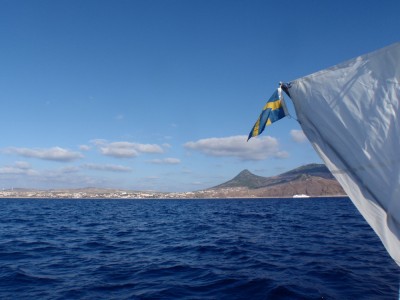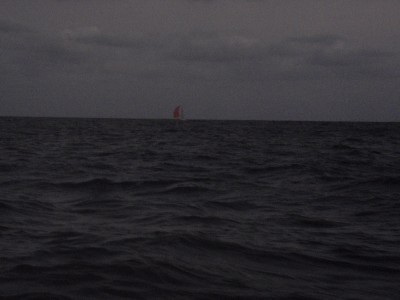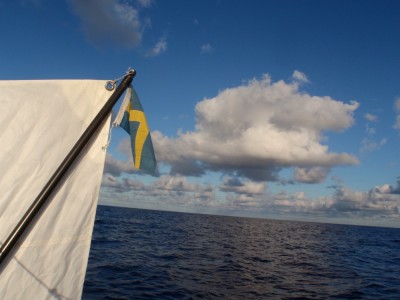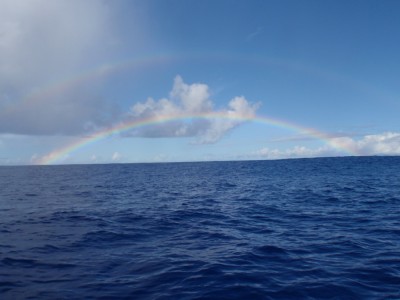IN 2012 I AM CELEBRATING MY FIFTY-ANNIVERSARY AS A SMALL BOAT SAILOR BY STARTING A NEW PROJECT. A NON STOP CIRCUMNAVIGATION IN A TEN FOOT BOAT EAST ABOUT, SOUTH OF THE CAPES.
The year 1962 was a milestone in my life. That year a 15 feet boat became my home and I set off in her on my first cruise to see the wide world.
Now fifty years later, 2012 I am back in Sweden after recently having sailed from Ireland to Martinique via Madeira in another 15-foot boat. I am ready for a new cruise.
In 2007 a challenge was posted on Internet for a race around the world in ten feet boats. A trophy was presented and eventually a starting date, Jan 10th 2009. Many names quickly filled the starting list as the word got around. People everywhere started to design and build small boats. Many forums on the Internet discussed the race. But, as the starting date approached one after the other of the competitors dropped out. Finally there was only the support boat left.
Now I have decided to make an effort to sail a ten feet boat non-stop around the world.
I will do the voyage differently, to my own rules. Crossing all the meridians is the classical definition of a world circumnavigation.
Mine will be a non stop sail east about, south of the great capes, Cape Horn, Cape of Good Hoop, etc.
Chichester wanted to be the first to sail around the world south of the capes. Unfortunately for him the great Argentinian solo sailor Vito Dumas had already done so in his boat Legh II. As a matter of course Dumas had sailed from his homeport Buenos Aires.
For Chichester a smart and ruthless man, that was not a problem. He changed the definition of circumnavigation. He argued that Dumas had not been to the northern hemisphere and that he therefore should be ignored.
Round the world records and Atlantic records do not measure the length. They are about, as the name implies, sailing around the world, or crossing the Atlantic. For example, when Gerry Spiess established a record by crossing the Atlantic in a ten-foot boat his sailed distance was 3300 nautical miles. Hugo Vihlen set a new record with a shorter boat but he sailed only 1900 miles. No one questioned the record because it is about crossing the Atlantic not about how many miles is sailed.
I do not agree with Chichester, nor do surely many Argentinians and other sane people. I will do as Dumas did, only sail in in the southern hemisphere. The sail will be long enough. As a bonus the risk of being run down by shipping and hitting floating containers will be reduced.
I will spend one year at sea. In order to pass Cape Horn in summer I will start and end the trip in the southern winter because I know that the waters south of the Horn are cold and dark in the winter. I experienced that in my homebuilt 19 feet long boat in June 1980, the southern winter. For that voyage I received the Royal Cruising Clubs medal of seamanship.
During my planned circumnavigation I will have no support, my 400 kilos of food should give me more than enough eating for the whole trip.
If by an unlikely chance I meet a boat that offers me an apple, or a few dollars, or a girl crew made of the right stuff, I will not hesitate to accept such a generous offer. Also if by chance I will pass a remote island in fine weather I may go ashore to stretch my legs, if I so fancy. I intend the sail to be a voyage of pleasure, an opportunity to be at sea where I can marvel at the fascinating maritime world in all its states of agitation. I will be living in a world of just the sea, the sky and me. That life in the wild southern high latitudes will purify and lift my spirit.
I will continue the voyage as long as it is fun.
What are my chances of success? I judge them to be extremely high, at least 50%. Here I realize I differ from the landlubber and the normal big boat sailor, and other ignorant people. I would not be surprised if they judged my chances to be less than 1%. Some of the ignorant ones may even think that it is a foolish idea and try to stop me.
But I do have qualifications. First, I have spent fifty years, the ones 1962 to 2012, designing, building, and sailing small boats.
During these fifty years I spent two six months periods cruising the southern high latitudes. The boats were 19 and 20 feet long respectively. Therefore I do consider myself not completely ignorant of how small boats behave in those stormy waters. Most of the sailing was done in the winter.
To specify, I rounded Cape Horn in June 1980. I sailed from Tristan da Cuhna to St Helena in June 1974. During that time I have seen some heavy weather. Three times during my four months cruise in the Falklands the wind was reported to have reached hundred knots.
Now as my philosophy has evolved into realize that, mass media, spices, coffee and other drugs do over stimulate us. I do my best to block out these undesirable influences by not having radio or TV, by not reading newspapers, by not using spices, coffee nicotine alcohol and other drugs. As a result my mind has become clearer and more sensitive to natural influences. At sea this is manifestly evident. I have never been so happy at sea as during my latest 45-day ocean passage from Madeira to Martinique in October – November 2011. And my boat has never been so small.
Good news was that my body easily tolerated the cramped salty environment.
I know that subtlety, not brute force will be the way to success. Therefore I will go small and smart. I will spend much time to design the boat in such a way that it will keep me dry in any weather; the sails will be easily handled from the hatch.
Small boats do not attract big forces. They do not need complex machinery. I will not have self-steering or autopilot. The longer a voyage is the more likely things are to break down. But also, the simpler a boat is the less chance there is of anything to break down. And in the case of breakdown, repair is easy, especially as I have built the boat myself.
Charles Lindbergh challenged and won the Orteig prize, the first to make a non-stop flight from New York too Paris. Many big syndicates with plenty of money had tried before him and many had crashed and died. Before Lindbergh’s famous flight he was known as the “Flying Fool”. That of course changed the minute he landed in Paris. He succeeded where others had failed by going small and simple. He flow solo in the one-engine airplane Spirit of St Louis, stripped of everything not absolutely necessary. The big complicated, overloaded planes with triple engines and several crews had crashed and killed its crews, one after the other.
I think that it is fantastic that Lindbergh succeeded in his small plane and I think it fantastic that the small and cheap boat that I plan to build has the potential to be at sea for over a year nonstop. I think that research into this kind of products should be encouraged. After all, few persons are rich enough to buy a big ocean going boat and our world is running out of its non-renewable resources and all these big things pollute our environment.
Five years ago when the “around in ten” race was announced. Voices where raised to forbid small, ocean going boats. It was said that it was suicide and madness. It was said that a small boat would not be able to clew of a lee shore, that the more time a boat was at sea the greater the risk of failure.
It is true that the bigger a boat is the better she goes to windward.
The risk of being blown ashore can however be sufficiently reduced to safe limits with common sense. I have never been even close to having that kind of trouble in my fifty years of cruising in small boats.
To exemplify what I mean here is how I planned the route of my latest voyage with “Yrvind.com” a fifteen, footer.
The boat had not been tested to windward in bad weather. Therefore prudently I planned my route accordingly. Instead of starting in Falmouth England, the usual starting point for crossing the Bay of Biscay. I started in Kinsale Ireland, that is 200 nautical miles further to the west. Thus the lee shore was 200 miles further to my lee, an ample margin.
Next I stopped in Porto Santo, Madeira. That well-protected port is just around of the east corner of the island. No lee shores there, no worry.
In Porto Santo I was a bit worried about my planned landfall in Florida, USA as I sailed during the hurricane season and if by bad chance I should be caught in a hurricane just as I approached the Florida lee coast. I was not to shore if I could manage to claw of in those conditions. With that in mind I changed my destination to Marin in southern Martinique. Marin is very easy to reach. It is just around the corner of southern Martinique and well protected up a narrow bay.
In fact when I reached Martinique it was very bad weather with heavy rainsqualls containing fifty knots wind. Having rounded the corner of southern Martinique, Marin was to windward up the bay. In fact my boat went excellent to windward. I think my failure to make her point high before was her short mast, now the strong wind healed her over mowing the center of effort to le. She went to windward like a train.
During my planned voyage I will sail in the southern high latitudes. A look at the globe will show that there is no lee shore there. In fact if you are at the southern tip of Cape Horn and keep sailing east following the 56 parallel of latitude there is no land until you come back to Cape Horn from the west, having circumnavigated the globe. Ergo, I will have no problem with a lee shore on this trip.
The other argument, that a smaller boat is slower than a bigger boat and therefore has to spend longer time at sea and therefore has a bigger the chance of failure sounds entirely logical, at first. But in this case it is a false argument because, time not distance, is the given quantity. For me the big thing is to spend a long time at sea, not to eat distance as quickly as possible.
What I mean is this; on land a person may tell his friends that this week end he will go camping to a nice lake. Normal campers do not try to get to the lake and back as quickly as possible. If they have been in the office all week they like to spend the whole weekend camping coming back Sunday evening refreshed.
Yachting people seems to be different, when they set out from the Canaries to the West Indies they try to get there as fast as possible. In fact the ARC is a race. If the speed drops below three knots or so, the engine is turned on. It seams those sailors cannot get back to civilization fast enough. They are focused on the next landfall and bored at sea.
For me it’s different. I like to be at sea. For me the purpose of sailing is to spend time at sea, not to be transported to another continent.
Now if the purpose is to spend time at sea, say one month, if the speed made during that month is fast rather than slow failure is much more likely to occur. Speed is dangerous. Speed kills. In this respect like in many others, big boats are more dangerous than small ones. The speed is higher. The forces are dangerously big. The machinery is more complex. That makes failure more likely. More and heavier things are thrown around when a big boat is capsizing. The distances you fall on a big boat are longer and a fall hurts you more. A fall overboard may even be fatal. Even the lifelines on a big boat are dangerous. The reason is it is so dangerous to fall overboard they have to be short to keep you inboard, on deck, but when the boat capsizes the short lines trap you under the boat and you drown. On my small boat I keep my lifeline long. If I should fall overboard the boat stops because the sail area is so small that the boat cannot drag me through the water. It is also very easy to climb back aboard. In fact when the water is warm I swim every day.
Do not tell me that a well-designed, well-built small boat is dangerous. It is the opposite. It is the big boats that are an accident-prone.
Small boats have a bad name because not many of the ones that go offshore are well designed and well built and many times the sailor do not have common sense. There are of course plenty of exception, a few modern names comes to my mind like Gerry Spiess, Robert Manry, and Serge Testa.
Finally if I chose not to go sailing, what do I have for alternative? Do like my fellow pensioners? Go out by a TV-set? Sit in the sofa every evening with the remote control, watching a bit here and a bit there and get bored? If I did I would lose my fitness. I would get fat. I might get diabetes and heart attacks. Then they would put me in old peoples home and connect me to an array of lifesaving machines. Chained to my bed I would suffer hell in my last decade and like many others in that situation try unsuccessfully to get a person to assist me into committing suicide. No, that is not my way. A man got to have something to live for.
Most people misunderstand life. Comfort does not make you happy. On the contrary, comfort makes you lazy, fat and bored.
Only by spending energy do you get more energy. It is the overflow of energy that makes you happy and healthy. Happiness cannot be bought for money.
During the planned voyage I will explore the small boats behavior in heavy weather, but equally, I will be on an inner voyage to higher spiritual realms. One hundred selected, non-fiction books will guide me.
Something about my childhood. I was born on the windward side of a small island in the North Sea. Our house was only a few meters from the water. Everyday in the good season until I was fifteen I played in the water for several hours each day. The water was my toy. Salt water has become my second nature. My ancestors on both my fathers and my mother’s side were sailors, sailing square-riggers round the Horn. My genes suit my challenge.
Not everyone is so fortunate and its amazing how many things can go wrong when things is not done right. But for the man with insight it is just as easy to do a thing right as to do it wrong. It’s a question of judgment.
I have a good track record, during these fifty years in my small home made boats I never had to ask for help and I always been happy at sea.
To help me to solve problems I have created a problem-solving system in five steps based on the fundamental principals. I started to build the base for it during the three years 1963 – 66 when I was studying mathematics. It has since then evolved into a very useful tool, which greatly aids my creativity. An example of the success of my method is my little sextant. It is not bigger than a fingernail and weighs only three grams (Se video on YouTube at Yrvind.)
To aid my thoughts designing the new boat, I will first build a 1:5 scale model of the new boat, then a sailing model in plywood in scale 1:1. And finally the strong real boat made of sandwich composite. I am always surprised how much I learn and how many new ideas I get when I make a mock up. It is definitely worth the extra time spent because I need all the help I can find. I have a difficult problem in front of me, but that is just what I like.
Also to help me find ideas I do frequently consult my library. It might be the world’s largest private collection of small boat literature. It contains about 100 shelf meters of nautical books. In addition I have another 100 shelf meter books on subjects related to cruising, such as medicine, physiology, mathematics, meteorology, aviation etc. I read books in the following languages Swedish, Danish, Norwegian, English, French, German and Mathematics.
For information I do not only rely on books I consult people who know more than me. A few of them are the following well-known persons:
James Wharram, catamaran designer who I met 1963
Lars Larsson professor in fluid dynamics and author of “Principles of yacht design” I met him 1969.
Hannicke Boon, catamaran designer. I met her in 1972.
Dick Newick, trimaran designer. I worked with him 1975 and 76.
Nigel Irens multihull designer. I met him 1981
Rolf Eliasson Yacht designer and author of “Principles of yacht design. I met him in 1981.
Matt Layden. Small boat designer and sailor. I met him 1997.
Gérard d’Aboville ocean rower and writer. I met him 2002.
I also consult many other gifted but less known persons in the boating community.
And my body? It is fit. I do run 12,3 kilometers on Sundays and 7 kilometers on Wednesdays, besides that I do strength training on Tuesdays and on Fridays.
One more advantage. I am a short man only 167 centimeters long. I eat no medicines.
Do I speak of my project to early? Well, what my heart is full of my mouth speaks. I realize that I do stick my neck out, but for me it would be not only difficult to hide my intentions but also stupid. I realize that if I fail I will have to eat crow. I do have a strong stomach.
Regards Yrvind
Like this:
Like Loading...




